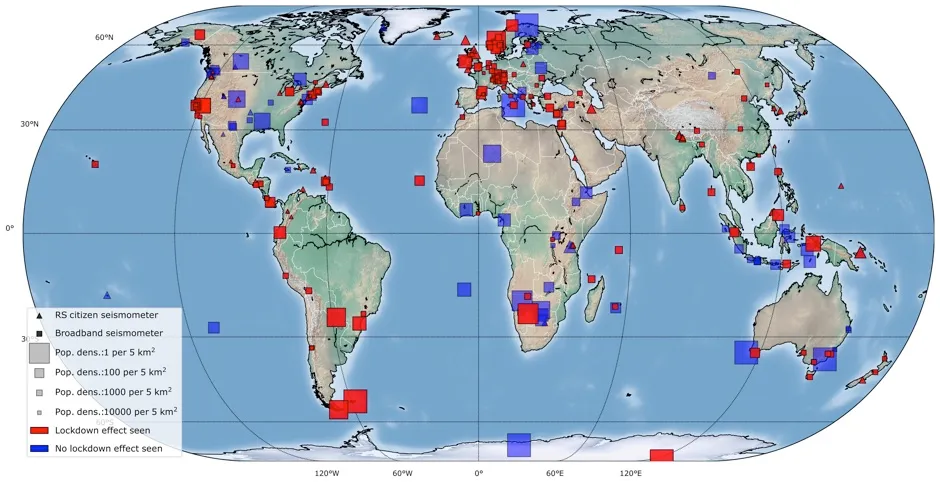Global ground vibrations, generated by human activities such as air and road traffic and industrial work, dropped by an average of 50 per cent between March and May 2020, scientists have found.
Researchers say the “drastic” drop in seismic background noise, brought on by COVID-19 lockdown measures implemented by many countries around the world, represents the “longest and most prominent global seismic noise reduction in recorded history”.
This months-long reduction in global seismic noise gave geoscientists an opportunity to spot natural events such as small earthquakes that may have otherwise remained undetected, especially during daytime when there is more human activity.
Read more about how the lockdown has impacted the world:
- Coronavirus: Is lockdown an opportunity for scientific research?
- Sleep in quarantine: Is the lockdown affecting our dreams?
- Mental health: Women and youth hardest hit by lockdown
The researchers believe their findings, published in the journal Science, could help scientists find ways to predict upcoming natural disasters.
Dr Thomas Lecocq, from the Royal Observatory of Belgium and lead author on the study, said: “With increasing urbanisation and growing global populations, more people will be living in geologically hazardous areas."

“It will therefore become more important than ever to differentiate between natural and human-caused noise so that we can ‘listen in’ and better monitor the ground movements beneath our feet.
“This study could help to kick-start this new field of study.”
A team of international researchers, which included scientists from Imperial College London, used devices known as seismometers to measure the noise caused by vibrations within the Earth.
Seismometers are normally used to record earthquakes and volcanic activity, but they also track the vibrations, or seismic noise, in the planet’s upper crust caused by humans.

The researchers looked at the data from 268 seismic stations in 117 countries, tracking the “wave” of quietening that began in China in late January 2020 and followed through to Europe and the rest of the world in March and April.
They found the dampening of human-generated seismic noise was more pronounced in more densely populated areas, like Singapore and New York City, but noise reductions were also seen in remote areas like Germany’s Black Forest and Rundu in Namibia.
Our study uniquely highlights just how much human activities impact the solid Earth
Dr Stephen Hicks, Imperial College London
Significant noise reductions were also observed around some universities and schools in the UK and the US, and according to the researchers, this drop in noise was 20 per cent larger than seen during school holidays.
The study authors wrote: “The noise level we observe during lockdowns lasted longer and was often quieter than the Christmas to New Year period.”
Meanwhile, countries like Barbados, where lockdown coincided with the tourist season, saw a 50 per cent decrease in noise, the researchers said.
The scientists are hoping their work will lead to further research on the hidden signals from earthquakes and volcanoes.
Dr Stephen Hicks, from Imperial’s department of Earth science and engineering, said: “This quiet period is likely the longest and largest dampening of human-caused seismic noise since we started monitoring the Earth in detail using vast monitoring networks of seismometers.
“Our study uniquely highlights just how much human activities impact the solid Earth, and could let us see more clearly than ever what differentiates human and natural noise.”
He added: “We hope this insight will spawn new studies that help us listen better to the Earth and understand natural signals we would otherwise have missed.”
Reader Q&A: How are the seismometers that measure earthquakes calibrated?
Asked by: Richard H Gray, Northern Ireland
Seismometers vary in design, but most modern ones use a heavy mass connected by springs to a frame. Often a magnetic field is applied, creating a force that maintains the position of the weight.
The frame is firmly attached to a geologically solid footing such as bedrock. Then, in a quake, the device vibrates with it. Through a negative feedback system, the magnetic field regulates itself to keep the mass still as the frame vibrates around it. The shifting magnetic field draws an electrical current that varies accordingly.
It’s this signal that the seismometer measures. The components are chosen to give a linear relationship between ground movements and seismographic measurements.
To calibrate the device, outputs are measured for a known range of displacements and frequencies.
Read more:
